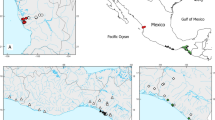Synopsis
Examination of 681 individuals of electric knife-fishes, Eigenmannia macrops, from the Orinoco River, Venezuela, revealed a pattern of morphological diversity which covaried with habitat. Fishes from the caños (small stream tributaries) are on average smaller than those from offshore habitats and lagoons. Even at the same body size the tails of caño fishes are relatively shorter, their bodies are deeper, and their heads are relatively wider than those from other habitats. Caño fishes are more different from fishes of the deep channels than from those of the shallow channels, beaches, or lagoons. Several factors are examined for their possible relationship to the origin of the observed diversity including electrophysiology, locomotory adaptation, growth rate and ecology. The problems of genetic versus physiological bases of morphological variation are addressed.
Similar content being viewed by others
References cited
Antonovics, J. 1971. The effects of a heterogeneous environment on the genetics of natural populations. Amer. Scientist 59: 593–599.
Avise, J.C. & M.H. Smith. 1974. Biochemical genetics of sunfish. I. Geographic variation and subspecific hybridization in the Bluegill, Lepornis macrocheirus. Evolution 28: 42–57.
Barlow, G.W. 1961. Causes and significance of morphological variation in fishes. Systematic Zoology 10: 105–117.
Bell, M. 1976. Evolution of phenotypic diversity in Gasterosteus aculeatus superspecies on the Pacific coast of North America. Systematic Zoology 25: 211–227.
Blake, R.W. 1983a. Fish locomotion. Cambridge University Press, Cambridge. 208 pp.
Blake, R.W. 1983b. Swimming in the electric eels and knife fishes. Can. J. Zool. 61: 1432–1441.
Brett, J.R. 1979. Environmental factors and growth. pp. 599–675. In: W.S. Hoar, D.J. Randall & J.R. Brett (ed.) Fish Physiology, volume 8, Academic Press, New York.
Chernoff, B. 1982. Character variation among populations and the analysis of biogeography. Amer. Zool. 22: 425–439.
Crickmay, C.H. 1974. The work of the river: a critical study of the central aspects of geomorphogeny. American Elsevier Publ. Co., New York. 271 pp.
Eldredge, N. & J. Cracraft. 1980. Phylogenetic patterns and the evolutionary process. Columbia University Press, New York. 349 pp.
Endler, J. 1977. Geographic variation, speciation and clines. Princeton University Press, Princeton. 246 pp.
Endler, J. 1983. Natural and sexual selection on color patterns in poeciliid fishes. Env. Biol. Fish. 9: 173–190.
Hagen, D.W. & D. MacPhail, 1970. The species problem within Gasterosteus aculeatus on the Pacific coast of North America. J. Fish. Res. Board Can. 27: 147–155.
Heiligenberg, W. 1975. Theoretical and experimental approaches to spatial aspects of electrolocation. J. Comp. Physiol. A. 103: 247–272.
Heyer, W.R., R.W. McDiarmid & D.L. Weigman. 1975. Tadpoles, predation and pond habitats in the tropics. Biotropica 7: 100–111.
Knudsen, E.I. 1975. Spatial aspects of electric fields generated by weakly electric fish. J. Comp. Physiol. A. 99: 103–118.
Lissman, H.W. 1961. Ecological studies on gymnotoids. pp. 215–223. In: C. Chagas & A. Paesde Varvalho (ed.) Bioelectrogenesis, Elsevier, Amsterdam.
Lopez-Rojas, H., J.G. Lundberg & E. Marsh. 1984. Design and operation of a small trawling apparatus for use with dugout canoes. N. Amer. J. Fish. Management 4: 331–334.
Mago-Leccia, F. 1978. Los peces de la familia Sternopygidae de Venezuela. Acta Cientifica Venezuela. 29, suppl. 1: 1–89.
Mago-Leccia, F., J.G. Lundberg & J. Baskin. 1984. Systematics of the South American fish genus Adontosternarchus (Gymnotiformes, Apteronotidae). Contr. Sci. Nat. Hist. Mus. Los Angeles County. (in print).
Poll, M. 1959a. Recherches sur la fauna ichthyologique de la region du Stanley Pool. Anals Mus. r. Congo Belge, Sci. Zool. 71: 75–174.
Poll, M. 1959b. Aspects nouveau de la fauna ichthyologique du Congo Belge. Bull. Soc. Zool. France 84: 259–271.
Sage, R.D. & R.K. Selander. 1975. Trophic radiation through polymorphism in cichlid fishes. Proc. Nat. Acad. Sci. U.S.A. 72: 4669–4673.
SAS Institute, Inc. 1982. SAS User's Guide Statistics. SAS Institute, Inc., Cary. 584 pp.
Steinbach, A.B. 1970. Diurnal movements and discharge characteristics of electric gymnotid fishes in the Rio Negro, Brazil. Biol. Bull. 138: 200–210.
Turner, B.J. & D.J. Grosse. 1980. Trophic differentiation in Ilyodon, a genus of stream-dwelling goodeid fishes: speciation versus ecological polymorphism. Evolution 34: 259–270.
Webb, P. 1975. Hydrodynamics and energetics of fish propulsion. Fish. Res. Board Can. Bull. 190, 158 pp.
Author information
Authors and Affiliations
Rights and permissions
About this article
Cite this article
Lundberg, J.G., Stager, J.C. Microgeographic diversity in the neotropical knife-fish Eigenmannia macrops (Gymnotiformes, Sternopygidae). Environ Biol Fish 13, 173–181 (1985). https://doi.org/10.1007/BF00000928
Received:
Accepted:
Issue Date:
DOI: https://doi.org/10.1007/BF00000928




